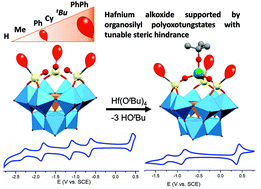Development of sterically hindered siloxide-functionalized polyoxotungstates for the complexation of 5d-metals†
Abstract
In this study, we extend the family of organosilyl-functionalized trivacant Keggin polyoxotungstates, [PW9O34(RSiOH)3]3− (R = nPr, iPr, tBu), through the introduction of bulky aryl and aliphatic silanol substituents, namely phenyl, cyclohexyl and biphenyl. This work was performed in order to study the impact of these large functional groups on the accessibility of the well-defined tridentate coordination site. Coordination of hafnium to these type II hybrid polyoxotungstates was conducted in order to study the ability of the bulkier ligand pockets to support larger cations in comparison to those previously reported (e.g. Ti4+, V3+, V5+, Ge4+). Increased steric hindrance around the coordination site from the biphenyl groups resulted in much longer reaction times for the complexation reaction compared to the other functional groups used, but the impact of our design toward stabilizing reactive species proved limited, as all complexes easily undergo hydrolysis of the Hf-OtBu bond in the presence of water. Electrochemical investigations of the ligands and hafnium complexes reveal that the redox events centered on the polyoxotungstate core can be tuned by varying the substituents on the silyl fragment, and exhibit a cathodic shift after coordination of the redox inactive tetravalent cation.



 Please wait while we load your content...
Please wait while we load your content...